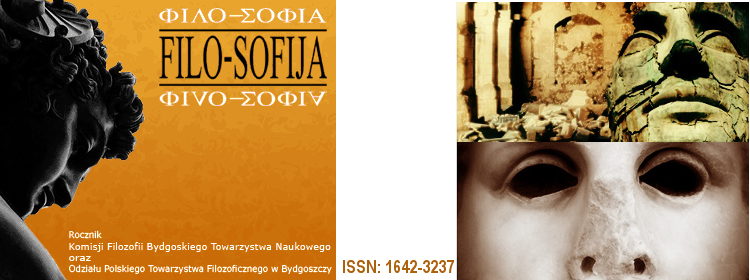Koncepcja twГіrczoЕ›ci WЕ‚adysЕ‚awa Tatarkiewicza a twГіrcze ЕєrГіdЕ‚o
Abstract
Author: Siwiec Marek Kazimierz
Title: WŁADYSŁAW TATARKIEWICZ’S VIEWS ON CREATIVITY WITH REGARDS to a Creative Source (Koncepcja twórczości Władysława Tatarkiewicza a twórcze źródło)
Source: Filo-Sofija
year: 2011, vol:.13/14, number: 2011/2-3, pages: 573-590
Keywords: CREATIVITY, CREATIVE SOURCE, PLURALISTIC AESTHETICS, WЕЃADYSЕЃAW TATARKIEWICZ, KARL JASPERS, BARBARA SKARGA, GEORG SIMMEL
Discipline: PHILOSOPHY
Language: POLISH
Document type: ARTICLE
Publication order reference (Primary author’s office address):
E-mail:
www:
Abstract In the essay – which consists of the three parts – the author tries to show Władysław Tatarkiewicz’s views on problems of the creativity as a basis to considerations on the creative source.
In the first part the author outlines a point of view of a creator such as an artist, a poet, a composer.
In the second part we can see the author sketching the problems of creativity and the creator itself. At the beginning he focuses on the Tatarkiewicz’s programme of pluralistic aesthetics with important discerning notions of aesthetics explicite and aesthetics implicite. The latter relates to works of art and the aesthetics views of the artists which can be found within. Afterwards he discusses main notions of the creator and the creativity i.e. poetic creativity, divine creativity, artistic creativity, human creativity. More carefully he examines contemporary approach of the creativity by Tatarkiewicz and analyses two criteria of it: high level of a novelty and a large outlay of an intellectual energy. The author notices a certain difficulty of the approach, namely a repetition of the intellectual energy in both criteria, yet he proposes a solution to the issue: first criterion relates to potential energy as a certain possibility, whereas the second relates to energy effectively implemented by the creator. He also discusses relation between the creativity and culture.
In the third part the author approaches the problems of the creative source. He discusses views of Karl Jaspers, Barbara Skarga and Georg Simmel.
In the conclusion the author defines the creative source as a task and a way of the creator. He points out that Tatarkiewicz’s view can be good groundwork to developing further considerations on the issue of the creative source.
Title: WŁADYSŁAW TATARKIEWICZ’S VIEWS ON CREATIVITY WITH REGARDS to a Creative Source (Koncepcja twórczości Władysława Tatarkiewicza a twórcze źródło)
Source: Filo-Sofija
year: 2011, vol:.13/14, number: 2011/2-3, pages: 573-590
Keywords: CREATIVITY, CREATIVE SOURCE, PLURALISTIC AESTHETICS, WЕЃADYSЕЃAW TATARKIEWICZ, KARL JASPERS, BARBARA SKARGA, GEORG SIMMEL
Discipline: PHILOSOPHY
Language: POLISH
Document type: ARTICLE
Publication order reference (Primary author’s office address):
E-mail:
www:
Abstract In the essay – which consists of the three parts – the author tries to show Władysław Tatarkiewicz’s views on problems of the creativity as a basis to considerations on the creative source.
In the first part the author outlines a point of view of a creator such as an artist, a poet, a composer.
In the second part we can see the author sketching the problems of creativity and the creator itself. At the beginning he focuses on the Tatarkiewicz’s programme of pluralistic aesthetics with important discerning notions of aesthetics explicite and aesthetics implicite. The latter relates to works of art and the aesthetics views of the artists which can be found within. Afterwards he discusses main notions of the creator and the creativity i.e. poetic creativity, divine creativity, artistic creativity, human creativity. More carefully he examines contemporary approach of the creativity by Tatarkiewicz and analyses two criteria of it: high level of a novelty and a large outlay of an intellectual energy. The author notices a certain difficulty of the approach, namely a repetition of the intellectual energy in both criteria, yet he proposes a solution to the issue: first criterion relates to potential energy as a certain possibility, whereas the second relates to energy effectively implemented by the creator. He also discusses relation between the creativity and culture.
In the third part the author approaches the problems of the creative source. He discusses views of Karl Jaspers, Barbara Skarga and Georg Simmel.
In the conclusion the author defines the creative source as a task and a way of the creator. He points out that Tatarkiewicz’s view can be good groundwork to developing further considerations on the issue of the creative source.
PeЕ‚ny tekst:
PDFAdministracja Cytowania | Strony czasopism
